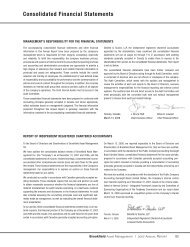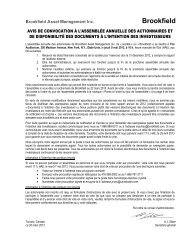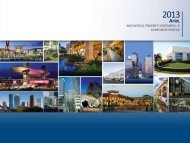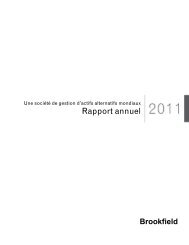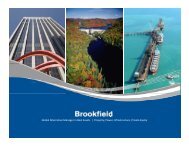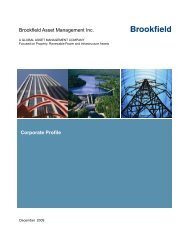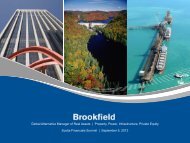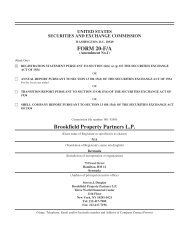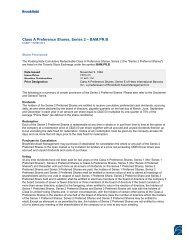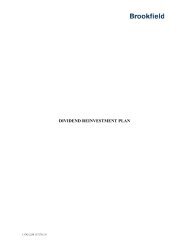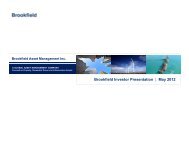Consolidated Financial Statements and Notes - Brookfield Asset ...
Consolidated Financial Statements and Notes - Brookfield Asset ...
Consolidated Financial Statements and Notes - Brookfield Asset ...
You also want an ePaper? Increase the reach of your titles
YUMPU automatically turns print PDFs into web optimized ePapers that Google loves.
designated as hedges are recorded on a settlement basis as an adjustment to power generation revenue. Premiums paid on optionsare initially recorded as assets <strong>and</strong> are amortized into earnings over the term of the option contract. Hedge accounting is discontinuedprospectively when the derivative no longer qualifi es as a hedge or the hedging relationship is terminated. Once discontinued, thecumulative change in fair value of a derivative that was previously deferred by the application of hedge accounting is recognizedin income over the term of the original hedging relationship.Derivative fi nancial instruments that are not designated as hedges are carried at estimated fair values, <strong>and</strong> gains <strong>and</strong> losses arisingfrom changes in fair values are recognized in the period the changes occur. Unrealized gains <strong>and</strong> losses on interest rate swapscarried to offset corresponding changes in the values of assets <strong>and</strong> cash fl ow streams that are not refl ected in the consolidatedfi nancial statements at December 31, 2005 <strong>and</strong> 2004 are recorded in future income taxes <strong>and</strong> other provisions. Realized <strong>and</strong>unrealized gains <strong>and</strong> losses on equity derivatives used to offset the change in share prices in respect of vested Deferred ShareUnits <strong>and</strong> Restricted Share Appreciation Units are recorded as an adjustment to other operating costs, along with the correspondingcompensation expense. Realized <strong>and</strong> unrealized gains on other derivatives not designated as hedges are recorded in investmentincome <strong>and</strong> other. The use of non-hedging derivative contracts is governed by documented risk management policies <strong>and</strong> approvedlimits. Derivative fi nancial instruments of a fi nancing nature are recorded at fair value determined on a credit adjusted basis.(l) Income TaxesThe company uses the asset <strong>and</strong> liability method whereby future income tax assets <strong>and</strong> liabilities are determined based ondifferences between the carrying amounts <strong>and</strong> tax bases of assets <strong>and</strong> liabilities, <strong>and</strong> measured using the tax rates <strong>and</strong> laws thatwill be in effect when the differences are expected to reverse.(m) Reporting Currency <strong>and</strong> Foreign Currency TranslationThe U.S. dollar is the functional currency of the company’s head offi ce operations <strong>and</strong> the U.S. dollar is the company’s reportingcurrency.The accounts of self-sustaining subsidiaries having a functional currency other than the U.S. dollar are translated using the currentrate method. Gains or losses on translation are deferred <strong>and</strong> included in the cumulative translation adjustment account. Gains orlosses on foreign currency denominated balances <strong>and</strong> transactions that are designated as hedges of net investments in thesesubsidiaries are reported in the same manner.Foreign currency denominated monetary assets <strong>and</strong> liabilities of the company <strong>and</strong> subsidiaries where the functional currency isthe U.S. dollar, are translated at the rate of exchange prevailing at period-end <strong>and</strong> revenues <strong>and</strong> expenses at average rates duringthe period. Gains or losses on translation of these items are included in the consolidated statement of income. Gains or losses ontransactions which hedge these items are also included in the consolidated statement of income.(n) Stock-Based CompensationThe company <strong>and</strong> most of its consolidated subsidiaries account for stock options using the fair value method. Under the fair valuemethod, compensation expense for stock options is determined based on the fair value at the grant date using an option pricingmodel <strong>and</strong> charged to income over the vesting period. The company’s publicly traded U.S. home building subsidiary records theliability <strong>and</strong> expense of stock options based on their intrinsic value using variable plan accounting, refl ecting differences in howthis plan operates. Under this method, vested options are revalued each reporting period, <strong>and</strong> any change in value is included inearnings.(o) Carrying Value of <strong>Asset</strong>sThe company assesses the carrying values of long-lived assets, when events necessitate a review, based on the net recoverableamounts determined on an undiscounted cash fl ow basis. If the carrying value of an asset exceeds its net recoverable amount, animpairment loss is recognized to the extent that the fair value is below the asset’s carrying value. Fair value is determined basedon quoted market prices when available, otherwise on the discounted cash fl ows over the life of the asset.(p) <strong>Asset</strong> Retirement Obligations, CICA H<strong>and</strong>book Section 3110Obligations associated with the retirement of tangible long-lived assets are recorded as liabilities when those obligations areincurred, with the amount of the liabilities initially measured at fair value. These obligations are capitalized to the book value of therelated long-lived assets <strong>and</strong> are depreciated over the useful life of the related asset.<strong>Brookfield</strong> <strong>Asset</strong> Management | 2005 Annual Report 67



